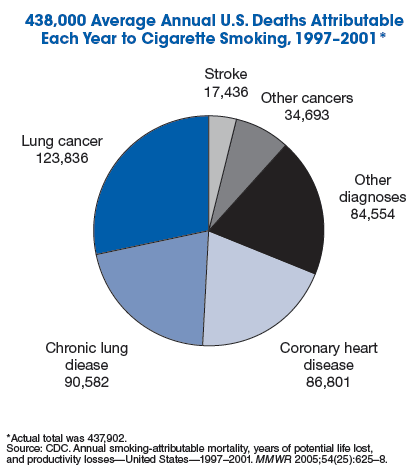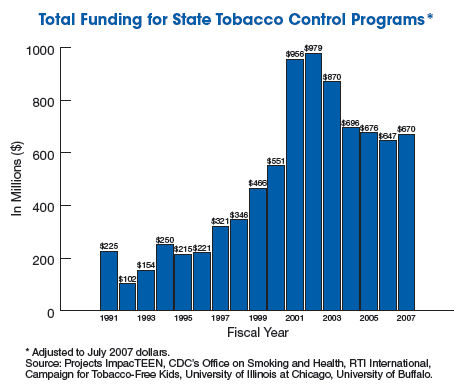 |

|
 |
 |
 |
Preventing Tobacco Use
The Reality
- Tobacco use is the leading preventable cause of death in the United
States, accounting for approximately 438,000 deaths each year.
- Smoking harms nearly every organ in the body and can cause chronic
lung disease, coronary heart disease, and stroke, as well as cancer of
the lungs, larynx, esophagus, mouth, bladder, cervix, pancreas, and
kidneys.
- Nearly 70% of the more than 45.3 million American adults who smoke
cigarettes want to quit.
- Approximately 80% of adult smokers started smoking before the age of
18. Each day in the United States, approximately 4,000 young people aged
12–17 years initiate cigarette smoking, and an estimated 1,140 young
people become daily cigarette smokers.
- If current smoking patterns in the United States persist,
approximately 5 million of today’s children will die prematurely of
tobacco-related diseases.
The Cost of Tobacco Use
- Coupled with this enormous health toll is the significant economic
burden of tobacco use—more than $96 billion per year in medical
expenditures and another $97 billion per year resulting from lost
productivity.
- About 14% of all Medicaid expenditures are for smoking-related
illnesses.
- Approximately 18.2 billion packs of cigarettes were sold in the
United States in 2007. Each pack cost the nation an estimated $10.60 in
medical care costs and lost productivity.
How Tobacco Control Saves Lives
- A New England Journal of Medicine report noted that the
California Tobacco Control Program was associated with 33,000 fewer
deaths from heart disease from 1989 through 1997. The incidence of lung
cancer decreased nearly four times more quickly in California than in
the rest of the United States, which is in part a result of
program-related reductions in smoking. During 1987–1997, an estimated
11,000 cases of lung cancer were prevented.
- Following the establishment of the Massachusetts Tobacco Control
Program, state rates of smoking during pregnancy dropped sharply, from
25% in 1990 to 13% in 1996. Eliminating smoking during pregnancy could
result in a 10% reduction in all infant deaths and a 12% reduction in
deaths from perinatal conditions.
How Tobacco
Control Saves Money
- Stopping the use of tobacco is the most cost-effective method of
preventing disease among adults. Each smoker who successfully quits
reduces the anticipated medical costs associated with heart attack and
stroke by an estimated $47 in the first year and $853 during the
following 7 years.
- Compared with nonsmokers, men who smoke incur nearly $16,000 more in
lifetime medical expenses; women who smoke incur more than $17,000.

(A text
version of this graphic is also available.) Effective Strategies
- CDC continues to support comprehensive programs to prevent and
control tobacco use in all 50 states, the District of Columbia, 7 U.S.
territories, and 7 tribal-serving organizations. CDC funds national
networks to reduce tobacco use among specific populations and provides
grants to 23 states for coordinated school health programs to help
prevent tobacco use.
- CDC’s Best Practices for Comprehensive Tobacco Control
Programs—2007 helps states plan, implement, evaluate, and sustain
their own tobacco control programs which reduce smoking-attributable
mortality, smoking prevalence, smoking initiation, and cigarette
consumption.
- The independent Task Force on Community Preventive Services strongly
recommends increasing the price of tobacco products, conducting mass
media campaigns, developing cessation interventions, reducing
out-of-pocket costs for treatment, and instituting smoking bans and
restrictions in public places.
- The more states spend on comprehensive tobacco control programs, the
greater the reductions in smoking. The longer states invest in such
programs, the greater and faster the impact. If states sustained their
individual recommended level of investment for 5 years, there would be
more than five million fewer smokers nationwide and hundreds of
thousands of premature tobacco-related deaths would be prevented.
Hope for the Future
The total recommended annual investment for the nation to fully fund
tobacco control programs is $3.7 billion, a fraction of the $13.4
billion the tobacco industry spends each year to market and promote
their products. The $3.7 billion investment recommended by CDC is only
2% of the cost for health care services and lost productivity resulting
from tobacco use and could be funded with just 17% of the nation’s
tobacco excise tax and tobacco settlement revenue. If states spent the
minimum amount recommended by CDC on tobacco prevention and control, the
rates of youth smoking rates could decline at rates seen previously.

(A text
version of this graphic is also available.)
State
Program in Action:
 New
York’s Tobacco Control Program Sustains Funding and Moves Closer to
Recommended Levels New
York’s Tobacco Control Program Sustains Funding and Moves Closer to
Recommended Levels
Over 25,000 New Yorkers die from tobacco use each year, and the
state annually incurs over $8 billion in medical costs resulting
from tobacco use. In response, the New York Tobacco Control Program
(NYTCP) wants to achieve three key goals by 2010: 1 million fewer
smokers, an adult prevalence rate of 14%, and a youth prevalence
rate of 10%. Clearly, reaching these goals requires a
tobacco-control effort focused on sustaining funding levels and
infrastructure.
According to CDC’s Best Practices for Comprehensive Tobacco
Control Programs—2007, the state of New York should be funding its
tobacco control program with an annual investment of $254.3 million.
New York has recorded an impressive increase in funding control
programs in recent years—from $32.5 million in 2000 to $85.5 million
in 2007. How did New York achieve such an increase?
NYTCP began requiring funded community partners to implement
sustainability plans and to report on their activities such as
monthly communication with local legislators and outreach to the
media. Also, the Center for a Tobacco Free New York and its partners
aggressively advocated for raising the tax on tobacco products which
increased funding. Additionally, independent evaluation reports have
been published annually for the past 4 years, and the results of the
program’s effectiveness are shared widely with legislators and other
decision makers.
NYTCP and its partners have been successful in using simple and
direct key messages:
- Tobacco use is an epidemic that impacts every community in
the state.
- Tobacco control works. Prevalence in New York is lower than
the national average: 18.2% for adults and 16.2% for high school
students.
- The longer states invest in comprehensive tobacco control
programs, the greater the impact. These programs also become
more cost-effective over time.
- A huge unmet need exists, which can be better addressed with
more financial resources.
- In New York, tobacco is an $8 billion problem—with a $250
million solution.
|
For more information and references supporting these facts, visit
www.cdc.gov/nccdphp. For
additional copies of this document, E-mail
cdcinfo@cdc.gov.
Department of
Health and Human Services
Centers for Disease Control and Prevention |
 |
Page last reviewed: October 15, 2008
Page last modified: October 15, 2008
Content source: National Center for
Chronic Disease Prevention and Health Promotion
|
 |
